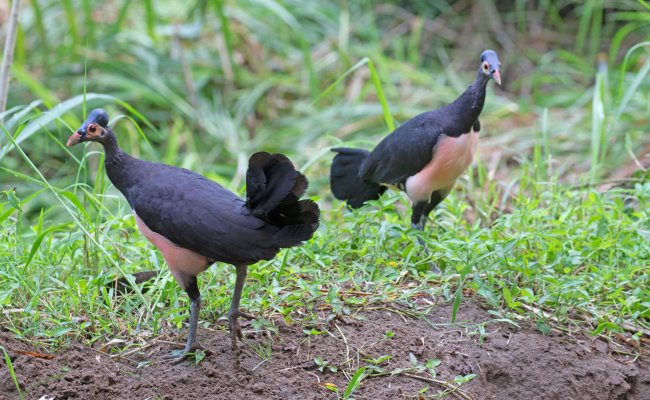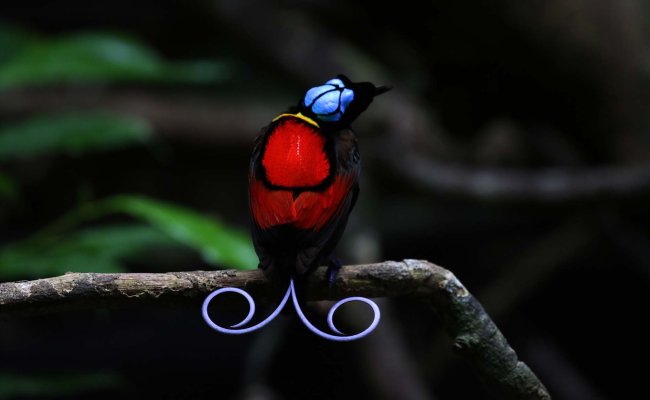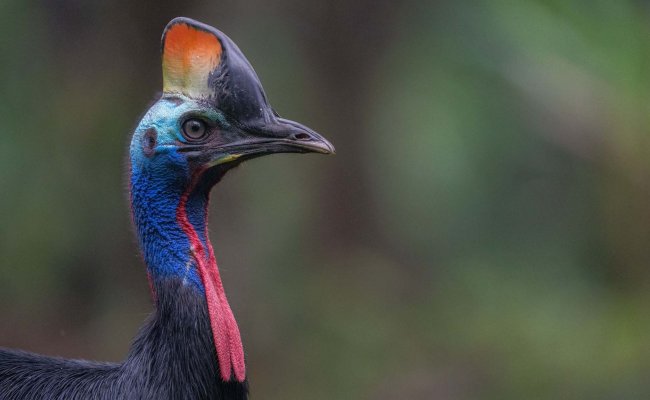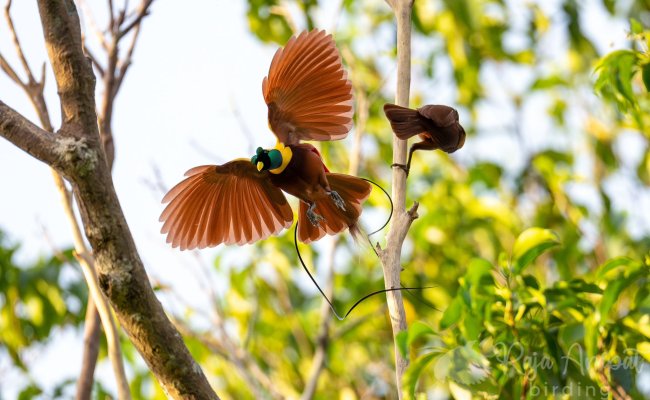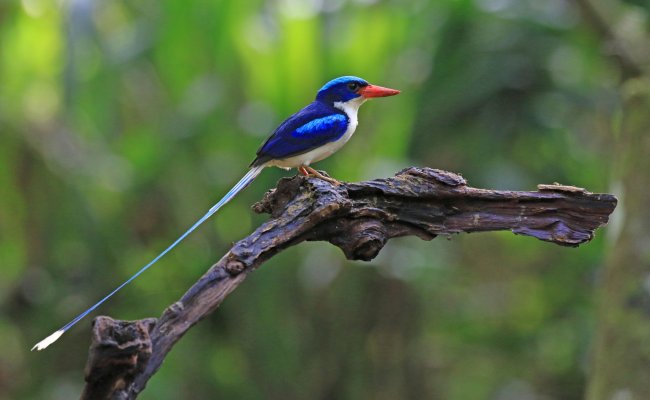SULAWESI and BIRDS
Some of the highest levels of endemism in the archipelago are found on Sulawesi. Of the 328 bird species known from the island, approximately 88 (27 %) are found nowhere else. Fourteen genera are so unusual that they are considered unique to Sulawesi. The beautiful, darting Purple-bearded Bee-eater, Meropogon forstein, and the raucous, colonial-nesting Finch-billed Myna, Scissirostrum dubium, are examples of bird endemic at the genus level. At least 280 bird species have been recorded from North Sulawesi, and two species, the Satanic nightjar, Eurostopodus diabolicus, and the Minahassa Masked Owl, Tyto inexspectatus, are found only on the northern peninsula.
Why are so many Sulawesi birds endemic? The question is answered in part by the age and isolation of the island. Geolagically, Sulawesi is very old and although the ocean strait between Borneo and Sulawesi may appear narrow, it poses a formidable barrier to dispersing birds.
SULAWESI KINGFISHER
Sulawesi’s Kingfisher relies on insects as well as fish and a few crabs to fill their platter. Darting with laser-like speed, they often leave no more than a blurred impression of shimmering blues, greens, and purples as they dive for a grasshopper or perhaps a small fish. Eleven species of Kingfishers have been recorded on Sulawesi and five of these are restricted to the island. Sulawesi’s kingfishers provide a textbook example of how several species with similar needs partition the environment. Great-billed kingfisher, Halcyon melanorhynca is primarily a coastal inhabitant, plying the beaches and streams for small fish while the Scaly-breasted Kingfisher, Actenoides princeps, prefers montane forests and unobtrusively forages in the lower canopy for insects. Several species including the tiny, purple Sulawesi Dwarf Kingfisher, Ceyx fallax, the Green-backed Kingfisher. Actinoides monachus, and the Lilac-cheeked Kingfisher, Cittura cyanotis, overlap in the lowland forest. Here, the habitat is partitioned vertically, with species differing in perch and foraging height.
BUNAKEN NATIONAL MARINE PARK
The Bunaken National Marine Park was formally established in 1991 and is among the first of Indonesia’s growing system of marine parks. The waters of Bunaken National Marine Park are extremely deep (1566 m in Manado Bay), clear (up to 35-40 m visibility), refreshing in temperature (27-29°C) and harbour some of the highest level of biodiversity in the world like corals, fish, echinoderms or sponges. The park has around 70 genera of corals and 2,500 species of fish or nearly 70% of all fish species known to the Indo-western Pacific, are found in Bunaken National Marine Park. The park covers a total surface area of 89,065 hectares, 97% of which is overlain by sparkling clear, warm, tropical water. The remaining 3% of the park is terrestrial, including the five islands of Bunaken, Manado Tua, Mantehage, Nain and Siladen.
Indonesia covers only 1.3 percent of the Earth’s surface yet it harbors 10 percent of all flowering plants and over a quarter of all marine and freshwater fish. Because of its extremely rich biodiversity, Indonesia has been claimed by some as the most important country on Earth for conservation.
MALEO (MACROCEPHALON MALEO)
Maleo is the most unusual bird in Sulawesi. This endemic bird is a member of a small family of so-called incubator birds, the Megapodidae, which are of Australian origin. The maleo is about the size of a domestic hec (1,6 kg) but its stylish black-and-salmon plumage and cocked tail give the bird more classy appearance. Maleo do not lay their eggs in a nest or incubate then with body heat. Instead they bury them near hot springs, volcanic vents or along exposed beaches where they are hatched by the sun, or by geothermal heat. The Megapodes and the Egyptian Plover are the only birds in the world that do not use their own body heat for incubation. During the egg-laying season, males and females arrive at communal nesting grounds, generally at night, and take turns the following morning digging deep holes in which the female will deposit an egg every 10 days or so. After the pair covers their eggs, they return to the forest, and have nothing more to do with their developing chicks. Hatching takes place after 3 months and its probably the most challenging event of a Maleo’s life. Maleos are communal nesters with hundreds of breeding pairs digging at one site. Experts estimate that there are 50 active sites in Sulawesi, and most of these are found in North Sulawesi. Nesting grounds at Gunung Ambang Natue Reserve and Bogani Nani Wartabone National Park are among several active sites. The Maleo is now Sulawesi’s most endangered bird species. Eggs hunters however continue to undermine conservation efforts and the future survival of this unique Sulawesi bird remains tenuous.
SULAWESI MAMMALS
The majority of Sulawesi’s mammals are bats and rats, with about 62 and 46 species, respectively. Both groups tend to be nocturnal, flying or scurrying about under the cover of night. With 515 species, Indonesia has more mammals than any other world, and Sulawesi is home to nearly 25% of these species. Of the 127 mammals on Sulawesi, 79 (62%) are endemic to the island-found no where else in the world. This odd collection of mammals contributes the most to Sulawesi’s distinctiveness and underscores the island’s importance for global biodiversity.
BABIRUSA (Babyrousa babyrussa); “Babirusa”
Babirusa or “deer pig” is the oddest and most famed animal in Sulawesi. Two large tusks grow up to pierce the ashy-grey skin of the snout before curling back in front of the eyes. The function of the tusks has intrigued many and remains somewhat of a mystery. They are not used, as once believed, as weapons that are locked during male-male combat. Like the long showy tails of a peacock, these oversized curly tusks may be used to advertise virility and attract mates. Females have normal canines but may find large-tusked males attractive. Babirusa are grouped with the pigs, although they differ from their more familiar relatives in several important ways. Today, Babirusa are among the most endangered animals of Sulawesi. A combination of slow reproductive rate, extensive hunting and habitat loss is the ideal recipe for endangerment and ultimate extinction. Trade in Babirusa may have begun with the early Sulawesi rulers, who presented this enigmatic animal as gifts to important visitors from other islands. Once plentiful throughout North Sulawesi, significant numbers of Babirusa can now only be found now in Bogani Nani Wartabone National Park and the Paguyaman River drainage to the west of the park.
CRESTED BLACK MACAQUES (Macaca nigra); “Yaki”
There are more species of macaques and tarsiers on Sulawesi than anywhere else in the world. Seven macaque species and three tarsiers found only in Sulawesi, inhabit the various sprawling arms and legs of the island. In North Sulawesi there is one species of tarsier and three species of macaques. The Crested black macaque (Macaca nigra) is found from the tip of the peninsula in the east to Kotamobagu in the west. The Dumoga-Bone macaque (Macaca nigrescens), occurs in the central region primarily within the Bogani Nani Wartabone National Park. The Heck’s macaque (Macaca hecki), is distributed from the west of the park into Central Sulawesi. Crested black macaques are among the largest of the Sulawesi macaques, a typical adult female weight around 7 kilograms, while an adult male may reach 11 kilograms. Crested black macaques, as their name implies, sport a long tuft of hair on the top of their head. Crested black macaques live in large groups of 30 – 100 animals. The groups are centered around female matriarchies, with females generally outnumbering males four to one. Groups spend nearly most of their time foraging for fruits, which comprise nearly 70% of their diets. Groups may move from as much as 4 km to as little as 1.5 km in a single day. Each group has a core area in which it spends most of its time, and groups have preferred sleeping sites. Crested black macaques have highly organized and complex social behavior. Adult males form dominance hierarchies, in which the largest, most dominant males get preferential access to food and mates. Adult females do most of the grooming, which allows the monkey to remove parasites from their fir and also helps the females strengthen social bonds with other group members. The Tangkoko Nature Reserve is one of the last strongholds for the dwindling population of black macaques in North Sulawesi. There are about 3000 monkeys remaining in the reserve. Macaques are hunted for food and pets throughout the year but they are particularly vulnerable in December when they are sought for traditional Minahasan Christmas dinners. Like many of the large mammals in Tangkoko, Crested black macaques are endangered and if current trends continue they may face extinction within the next 25 years.
SPECTRAL TARSIES (TARSIUS SPECTRUM); “TANGKASI OR SINGAPUAR”
One of the most remarkable sounds of the forest is produced by the diminutive Spectral tarsies. Their ear-piercing cries defy the size of the animal; adult tarsier weight little more that 100 grams, placing them among the world’s smallest primates. The enormous size of the eyes, sensitive ears that move independently of one another, large needle-sharp teeth, and an extraordinary capacity to rotate their head nearly 180°, indicate the tarsier’s nocturnal, predatory habits and impart a gremlin-like character. Hind limbs, twice the length of their head and body combined, provide the power behind their famous leaps. The second and third does are equipped with long, decurved talons, called toilet claws, used for grooming while the other toes and the long, slender fingers bear ordinary nails.
Tarsier are considered to be primitive primates and biologist categorize them somewhere the monkeys and the prosimians, another primarily nocturnal group of primates that includes the bush-babies of Africa and the lemurs of Madagascar. As a group, tarsiers are unusual in their distribution because they are found on both sides of Wallace’s Line, the artificial boundary that marks the division between the Eurasian and Australasian fauna. This is an indication of the tarsiers’ long residence in the region, possibly going back more than 40 million years. T. spectrum however, is restricted to Sulawesi and small adjacent islands.
Tarsiers are territorial, defending areas from neighboring groups and possible intruders. Territorial boundaries are marked with urine and occupancy is announced every morning and evening as males and females sing their hunting duets. Although most territories are defended by a monogamous pair and their offspring, there is considerable variation in group size and composition, with some groups containing more than one breeding adult female. Sleeping trees are central to the life of a tarsier and all tarsier territories contain at least one sleeping site. Bamboo thickets, vines tangles, and hollow trunks are used as sleeping sites but the most favored spots are the intertwined roots of large strangler figs.
After leaving a sleeping site, typically 10-20 minutes after sunset, the group spends a few minutes interacting before members leap off in different directions. Males use an area as large as 4 ha while females occupy much smaller ranges of around 1-2 ha.
In North Sulawesi, tarsier births tend to occur in May and November. Tarsiers give birth to a single, fully furred and open-eyed young after 180 days gestation. At birth the infant weights almost one-quarter as much as its mother and for several weeks is carried around in the mother’s mouth like a kitten. While hunting, the female often “parks” her young on a branch communicating with soft clicks and whistles.
Tarsiers are insectivorous and spend over 50% of their night chasing insects. They take arthropods including ants, beetles, moths, and cockroaches. Prey is caught by leaping at it and pinning it down or trapping it in the cage of their long, slender fingers. An occasional lizard or gecko may be taken but this is rare. The meal of choice is most likely a caterpillar or grasshopper.
North Sulawesi is one of the best places in the world to see tarsiers. Although rare outside parks and reserves, because of habitat loss and being hunted for pets, they are abundant within protected areas where they appear to find safe sanctuary. In the Tangkoko Nature Reserve, tarsiers occur at densities high as 82/km².
INVERTEBRATES
North Sulawesi is a home to tarantulas, scorpions, walking sticks, cicadas, ants big and a host of other species far too numerous to list. Many bites, sting, itch and infuriate. Two of the most infamous are the blood-sucking leeches and “gonones”, small mites that cause terrible itching. Luckily the two rarely occur together, leeches preferring moister regions and then mites. Both are harmless but rarely welcome. The number of “gonone” bites may be reduced by spraying ankles and waistlines with insect repellent before entering the forest and by avoiding sitting on rotting logs. Despite the often irritating and ornery behavior of intervertebrates, one should never be deterred by their minor annoyances. Invertebrates can inspire the observer with their beauty and wondrous forms of adaptation to their varied habitats.
About 1,4 million kinds of living organism have been described by science, and roughly 1 million are invertebrates, a grab-bag collection of animals that includes everything from sponges and corals to worms, starfish and spiders. A full 75% of the invertebrates are 6-legged insects, making them the most numerous creatures in the world, and it is highly plausible that this is a vast underestimate. Indeed, as we begin to explore deep sea floors, coral reefs and the soils and treetops of tropical forest, the numbers of invertebrates may increase by orders of magnitude, some biologists have estimated as many as 30 million species. A short collecting trip to Bogani Nani Wartabone National Park in 1985 yielded no less that 120 previously unknown species. Besides being numerous, invertebrates have important jobs in natural ecosystems. Sponges, clams and oysters filter the sea. Termites, ants and earthworms till the soil and recycle nutrients. Preying mantis, spiders and certain wasps act as the nuisance control team by preying on other pesky insects. Insects are superior pollinators, butterflies, moths and bees are the cupids of the forest assuring future generations.
REPTILES & AMPHIBIANS
North Sulawesi’s oceans are the haunts of two groups of reptiles, the sea snakes and sea turtles. Sea snakes belong to the same family as cobras and are just as deadly. Unlike their unpredictable relatives, however, they have a docile personality and may be approached safely by a cautious swimmer. The grey-and-black banded sea snake (Laticauda colubrina), is commonly encountered off Bunaken Island, lithely whipping its serpentine body to the surface to gulp air.
Sulawesi harbors at least 64 snake species, 23 of which are endemic. Although the majority are harmless, the few venomous species are extremely dangerous. The King cobra (Ophiophagus hannah), specializes in eating other snakes and is one of the most poisonous in the world. Most famous of the snakes are the Reticulated pythons (Python reticulatus). These snakes have a captivating, iridescent rainbow sheen to their scales and are well known for suffocating their victims in a coiling death grip.
Four species of sea turtles ply North Sulawesi’s waters and depend on its beaches for egg-laying. Females are site-specific in their nesting habitats, returning each time, from thousands of kilometres away, to the same beach. Between March and September, on the more scheduled beaches of Tangkoko Nature Reserve, Panua Nature Reserve and island of Bunaken Marine National Park, female turtles haul out at night to deposit their large clutch of eggs (over 200 eggs for some species) above the water high mark where they will hopefully hatch in 45-80 days. The sea turtle species found in Sulawesi differ dramatically in size, shape and preferred meals. The most commonly seen is the green turtle (Chelonia mydas), or “Penyu Hijau”. This olive-green turtle is about 1 meter long, weights nearly 100 kg and feeds almost entirely on seagrasses.
The loggerhead turtle (Caretta careta), is similar in size and shape to the green turtle but can be distinguished by its darker brown color and massive head. Locally known as “Penyu Tempayan”, this species feeds on crustaceans and mollusks. The callosal leatherback turtle (Dermochelys coriacea), locally known as belimbing, thus the common Sulawesi name “Penyu Belimbing” is one of the largest living reptiles, surpassed only by some crocodiles. The hawksbill turtle (Eretochelys imbricata) or “Penyu Sisik”, is named for its distinct beak with which it feeds on coral reef invertebrates.
TIPS ON VIEWING WILDLIFE
- Dress appropriately, wear light, breathable clothing that dries quickly. Drab colors are preferable; avoid whites and reds. Although it is hot, long sleeves and pants prevent scratches and insect bites. Use insect repellent and tuck your pants into your socks to minimize insect, leech and mite bites
- Carry good binoculars; without them even the most spectacular birds will be no more than a shiny dot in the canopy. Carry a waterproof bag big enough for binoculars and cameras in case of a downpour.
- Go slowly, quietly and in small groups (no more than 5) so animals will be less likely to be disturbed by your presence.
- Seek out fruiting trees, especially figs, or pools and streams. These are profitable places to sit and wait for wildlife, particularly birds.
- Sit often and for long periods and search for the things that tend to go unnoticed like glossy beetles, graceful butterflies, velvet ants, and exquisite but minute flowers.
- Be aware of sounds, the buzzing of insects, calls of birds, rustling in the underbrush. Quite often these cues are the first indication that something is about to happen.
- Go early. Most birds and many mammals are active in the morning with their movements dropping off by midday. The afternoon peak is never as energetic as the morning but these are good times to visit streams and water resources.
- When viewing monkeys, let them approach you on their own terms. If you stoop down and avoid looking directly in their eyes they will be less inhibited. Do not chase or pursue monkeys and never feed them. No matter how innocent they may look, wild monkeys bite and carry dangerous diseases.
- When viewing tarsiers at night don’t forget your flashlight however be considerate of their extremely sensitive eyes.
 Maleo, Image by Mohamad Naliko
Maleo, Image by Mohamad Naliko
